Galveston in Galveston County, Texas — The American South (West South Central)
Original Site of St. Mary's Orphan Asylum
Children orphaned by a yellow fever epidemic in 1867 were cared for temporarily in Galveston's St. Mary's Infirmary by the Sisters of Charity of the Incarnate Word. In 1874 Galveston Bishop Claude Dubuis bought the 35-acre plantation and home of Farnifala and Laura Green located between this gulf front and Green's Bayou for use as a permanent orphanage. In early 1874 the Sisters of St. Mary's Infirmary founded St. Mary's Orphan Asylum by housing 28 children here at the site of the Greens' former residence. A 2-story facility for orphan girls was built nearby in October 1874.
The girl's dormitory was all that remained of the orphanage after the storm of 1875. A new residence for boys was built by 1879. St. Mary's was caring for orphans from throughout Texas at the time it was granted a Texas charter in 1896.
The catastrophic storm of 1900 completely destroyed the orphanage. Ten nuns and at least 90 children were tragically killed despite the nuns' valiant efforts to save the children by securing them to their own bodies with clothesline. Three orphan boys rescued at sea were the only survivors. St. Mary's Orphan Asylum reopened at 40th and Q streets in Galveston City in 1901 and remained there until closing in 1967.
Erected 1994 by Texas Historical Commission. (Marker Number 7175.)
Topics. This historical marker is listed in these topic lists: Charity & Public Work • Churches & Religion • Disasters. A significant historical year for this entry is 1874.
Location. 29° 15.772′ N, 94° 49.96′ W. Marker is in Galveston, Texas, in Galveston County. Marker is on Seawall Boulevard east of 69th Street, on the right when traveling east. Marker is a large metal plaque mounted directly on a large, beveled cement pedestal, and located along the seawall sidewalk, overlooking Galveston Beach. Touch for map. Marker is in this post office area: Galveston TX 77551, United States of America. Touch for directions.
Other nearby markers. At least 8 other markers are within walking distance of this marker. Rosewood Cemetery (approx. 0.4 miles away); a different marker also named Rosewood Cemetery (approx. 0.4 miles away); "Ducky's Beach" (approx. 0.6 miles away); The Italian Vault (approx. 0.7 miles away); Valentine T. Dalton (approx. 0.7 miles away); Greek Orthodox Cemetery (approx. ¾ mile away); Peter Leroy Colombo (approx. ¾ mile away); Burial Site of David G. Burnet (1788-1870) (approx. 0.8 miles away). Touch for a list and map of all markers in Galveston.
Also see . . .
1. The Sisters of Charity Orphanage Tragedy Remembered. (This link presents a picture of the Orphanage circa 1890.) Striking Galveston on Sept. 8, 1900, the
Great Storm is considered the worst natural disaster in the nation's history.
More than 6,000 men, women and children lost their lives. Among the dead were 10 sisters and 90 children from the St. Mary's Orphans Asylum, operated by the Sisters of Charity.
On Sept. 8, 1994, this Texas Historical Marker was placed at 69th Street and Seawall Boulevard, marking the site of the former orphanage.
The descendants of two of the survivors, Will Murny and Frank Madera, returned to participate in the marker dedication. (Submitted on May 14, 2018, by Cosmos Mariner of Cape Canaveral, Florida.)
2. St. Mary's Orphanage, Galveston, Texas. Early in its history the orphanage fell prey to a series of disasters. In 1875 one of the old buildings that housed twelve children under two years old was destroyed by fire; no lives were lost. Between September 15 and 17 of that year a severe storm completely destroyed the old Green Bayou residence and badly damaged the new building. The orphanage remained at Green's Bayou, however, until the buildings were washed away by the onslaught of the Galveston hurricane of 1900. (Submitted on May 14, 2018, by Cosmos Mariner of Cape Canaveral, Florida.)
3. Portrait of a Legend: The Great Storm of 1900: St. Mary’s Orphan Asylum. The nuns at St. Mary’s, in a desperate attempt to save their young charges, relocated the children from the boys’ dormitory to the new girls’ dormitory. From there, they watched the boys’ dormitory succumb to the relentless winds and water. As winds raged at 150 mph, the nuns decided to tie a piece of clothesline around each of their waists and then around the wrists of about six or eight children. Soon after, the mighty storm lifted the girls’ dormitory off its foundations, causing the building’s bottom to fall out and sending its roof crashing down, trapping its inhabitants. Only three children survived the catastrophe - the boys wound up in the water and awoke to find themselves clinging to a tree, upon which they floated for nearly a day. (Submitted on May 14, 2018, by Cosmos Mariner of Cape Canaveral, Florida.)
4. Galveston's Response to the Hurricane of 1900. The fact that the city of Galveston exists today is the triumph of imagination, hope and determination over reality. Perched precariously on a sand-barrier island in the Gulf of Mexico, Galveston is subject to the whims of inevitable hurricanes. One of those hurricanes, dancing its deadly way across the Gulf of Mexico in early September 1900, came very close to dealing the city a fatal blow. Galveston's leaders took several major steps to recover from the storm and to prevent a recurrence of the devastation. First, they developed a new form of municipal government, one with strong centralized control to handle the economic recovery of the city. Next, they built a massive seawall to turn back storm-generated waves. Perhaps the most amazing step they took was to raise the level of the entire city, by more than 16 feet in some areas, in order to keep flooding at a minimum. (Submitted on June 19, 2018, by Cosmos Mariner of Cape Canaveral, Florida.)
Credits. This page was last revised on June 20, 2018. It was originally submitted on May 14, 2018, by Cosmos Mariner of Cape Canaveral, Florida. This page has been viewed 1,193 times since then and 146 times this year. Photos: 1, 2. submitted on May 14, 2018, by Cosmos Mariner of Cape Canaveral, Florida. • Bernard Fisher was the editor who published this page.

